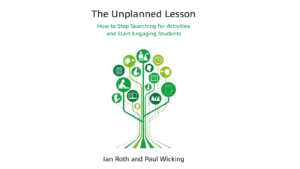“Film in Action: Teaching language using moving images”: Book Review
Teachers around the world attempt to engage their learners using various methods, one of which is the use of video in the classroom. When reflecting on video, I remember, within my first year of teaching, attempting to get all the young learners motivated by watching a cartoon or child-friendly movie. However, I was fresh out of ideas on how to exploit it in an educational manner. What I tended to do was just wheel out the TV and DVD player into the classroom and hit the play button. We would all just sit there and watch the DVD, totally immersed within the video with very little educational benefit. Now with the development and popularity of online video distribution websites, as well as smart mobile filming devices, teachers are now in the position to motivate and engage their learners with the language of English via the medium of video.
It now seems fitting that the latest publication from the DELTA Teacher Development Series attempts to illustrate the educational benefit by which teachers, and their learners, could use video to supplement the teaching of English. “Film in Action” (2015), written by Kieran Donaghy, is a wonderful resource for teachers seeking further ideas on how to exploit video inside and outside the classroom with their learners. As with previous publications from the DELTA Teacher Development Series, you can expect three parts to this book: Part A, Part B and, if you hazard a guess, Part C. Within Part A, Kieran attempts to answer six key questions related to:
- The role of film within society;
- Film within education;
- The relationship between film and literacy in the twenty-first century;
- The importance of the young analysing and creating their own personal films;
- The educational benefits of creating moving images; as well as
- Strategies to using films inside and outside of the classroom.
Each focus is clearly written, with reference to further reading in the bibliography, which guides the reader towards the relationship between education, film and teaching. The final focus of Part A – using film in the classroom – offers some invaluable and reflective tips for using feature films or short films in creative and educationally rewarding ways. Part A offers the reader websites related to short films, general film resources as well as additional lesson plans and projects.
Part B, which offers a wealth of lesson ideas, is split into two chapters: Chapter One focuses on learners actively watching film with the aim of improving their language skills as well as developing their visual literacy, while Chapter Two offers concepts of lessons designed to encourage learners to actively produce their own film with a focus on English. Chapter One, which contain in total 68 lesson ideas, in the predictable lesson structure which is clear, methodical and well organised. This simple and effective process, as with all of the DELTA Teacher Development Series, offer readers inspired lessons to incorporate films within the classroom. All the lesson ideas in this section are further split into 8 other categories related to actively watching film: exploring film (7 lesson ideas), exploiting moving images (12 lesson ideas), exploiting still images (7 lesson ideas), exploiting sound (12 lesson ideas), exploiting music (4 lesson ideas), analysing characters (8 lesson ideas), analysing scripts (8 lesson ideas) as well as exploring new film genres (10 lesson ideas).
Chapter Two, within Part B, focuses on learners producing and creating their own films in an educational manner. It is, again, clearly organized using the DELTA Publishing formula. The focus of learners actively producing their own films, of which there are 43 lessons, is split into three main areas: creating narrative (15 lesson ideas), creating images and sounds (9 lesson ideas) and creating moving images (19 lesson ideas). One of my favourite lesson ideas, within Chapter Two, Part B, is getting learners to create a ‘how to’ video. Kieran has written a wonderful lesson plan which naturally develops towards students creating their very own ‘how to’ video. The lesson itself is incredibly powerful as students are no longer restricted by the topic. They can work together to create a video, which can then be played back to the rest of the class.
There is a natural development towards Part C, which considers the adoption of a ‘three C’ approach to film: Cultural access, Critical understanding and Creative activity. Kieran considers exploiting the three Cs approach, within Part C, by considering four projects which readers could incorporate within their classroom: the film club, film circles, film chronicles, and the film course. With these four considerations, which any language institution could incorporate to supplement language courses, the author highlights very important aspects to consider. For example, with a film club the reader is reminded to consider equipment required, the environment, legal implications as well as selecting appropriate films. Additional resources and lesson ideas are offered for readers in the final Part, with readers feeling motivated to attempt film projects with their educational institution.
The book itself covers a variety of areas with film in the classroom in a well-defined and logical fashion that naturally guides the reader towards different aspects to consider when incorporating film in the classroom. Readers will gain confidence and inspiration when incorporating ideas suggested by Kieran Donaghy. There is such a wealth of recommended websites and links that it can initially seem daunting for any reader. Yet, with enough perseverance and determination, these websites can support and complement the lesson ideas. “Film in Action” is a vital book for those teachers wishing to incorporate film in the classroom with some stimulating and rewarding ideas for lessons. It would have saved me countless times when I incorporated film in the classroom.




